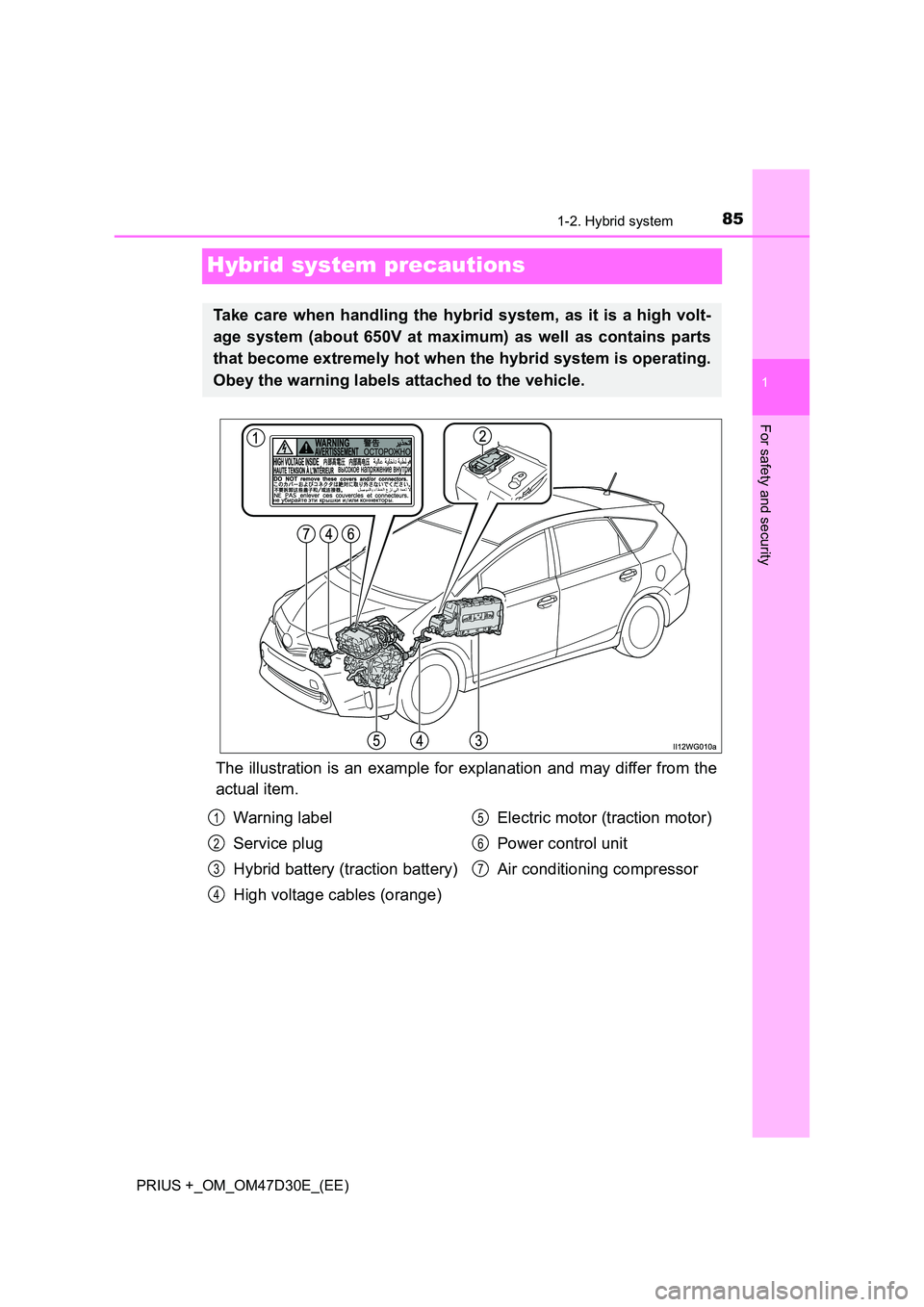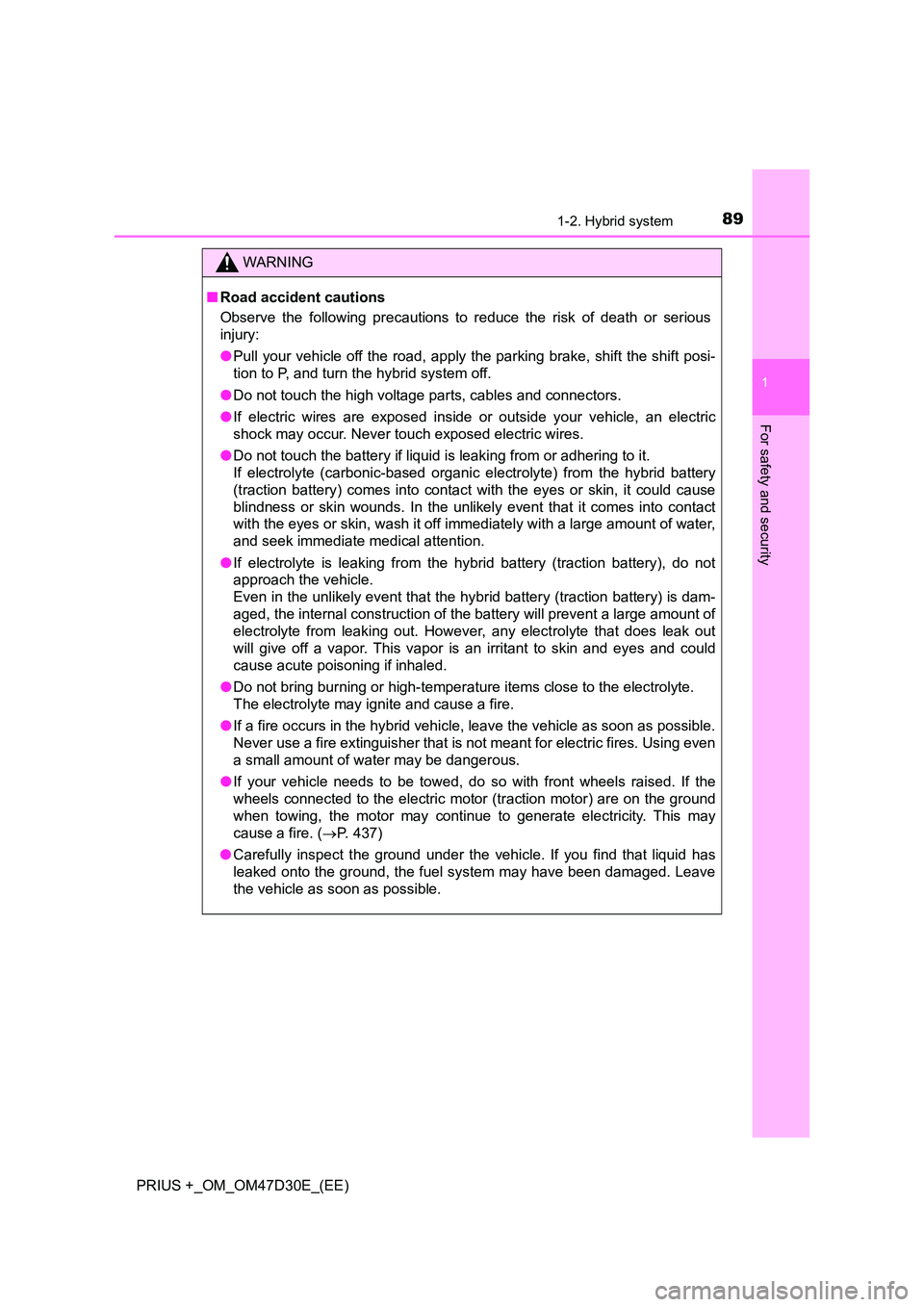2019 TOYOTA PRIUS PLUS battery
[x] Cancel search: batteryPage 5 of 568

5
1
8
7
6
5
4
3
2
PRIUS +_OM_OM47D30E_(EE)
6-3. Do-it-yourself maintenance
Do-it-yourself service
precautions ......................373
Hood ..................................375
Positioning a floor jack .......377
Engine compartment..........379
12-volt battery ....................389
Tires ...................................393
Tire inflation pressure ........409
Wheels ...............................411
Air conditioning filter ..........413
Wiper rubber
replacement .....................415
Electronic key battery ........417
Checking and replacing
fuses ................................419
Light bulbs .........................423
7-1. Essential information
Emergency flashers ...........434
If your vehicle has to
be stopped in an
emergency .......................435
If the vehicle is trapped in
rising water ......................436
7-2. Steps to take in an
emergency
If your vehicle needs
to be towed ..................... 437
If you think something is
wrong .............................. 443
If a warning light turns on
or a warning buzzer
sounds ............................ 444
If a warning message is
displayed ......................... 458
If you have a flat tire
(vehicles with spare
tire) .................................. 478
If you have a flat tire
(vehicles without spare
tire) .................................. 492
If the hybrid system will
not start ........................... 509
If the electronic key does
not operate properly ........ 511
If the 12-volt battery is
discharged ...................... 513
If your vehicle
overheats ........................ 518
If the vehicle becomes
stuck................................ 523
7When trouble arises
Page 82 of 568

821-2. Hybrid system
PRIUS +_OM_OM47D30E_(EE)
◆When stopped/during start off
The gasoline engine stops* when the vehicle is stopped. During
start off, the electric motor (traction motor) drives the vehicle. At
slow speeds or when traveling down a gentle slope, the engine is
stopped* and the electric motor (traction motor) is used.
When shift position is in N, the hybrid battery (traction battery) is not
being charged.
*: When the hybrid battery (traction battery) requires charging or the engine
is warming up, etc., the gasoline engine will not automatically stop.
( P. 83)
◆During normal driving
The gasoline engine is predominantly used. The electric motor
(traction motor) charges the hybrid battery (traction battery) as nec-
essary.
◆When accelerating sharply
When the accelerator pedal is depressed heavily, the power of the
hybrid battery (traction battery) is added to that of the gasoline
engine via the electric motor (traction motor).
◆When braking (regenerative braking)
The wheels operate the electric motor (traction motor) as a power
generator, and the hybrid battery (traction battery) is charged.
■ Regenerative braking
In the following situations, kinetic ener gy is converted to electric energy and
deceleration force can be obtained in c onjunction with the recharging of the
hybrid battery (traction battery).
● The accelerator pedal is released while driving with the shift position in D or
B.
● The brake pedal is depressed while driving with the shift position in D or B.
Page 83 of 568

831-2. Hybrid system
1
PRIUS +_OM_OM47D30E_(EE)
For safety and security
■Hybrid System Indicator
■ Conditions in which the gasoline engine may not stop
The gasoline engine starts and stops automatically. However, it may not stop
automatically in the following conditions:
● During gasoline engine warm-up
● During hybrid battery (traction battery) charging
● When the temperature of the hybrid battery (traction battery) is high or low
● When the heater is switched on
■ Charging the hybrid battery (traction battery)
As the gasoline engine charges the hybrid battery (traction battery), the bat-
tery does not need to be charged from an outside source. However, if the
vehicle is left parked for a long time the hybrid battery (traction battery) will
slowly discharge. For this reason, be sure to drive the vehicle at least once
every few months for at least 30 minutes or 16 km (10 miles). If the hybrid
battery (traction battery) becomes fully discharged and you are unable to start
the hybrid system, contact any authorized Toyota retailer or Toyota authorized
repairer, or any reliable repairer.
■ Charging the 12-volt battery
P. 516
■ After the 12-volt battery has discharged or when the terminal has been
removed and installed during exchange, etc.
The gasoline engine may not stop even if the vehicle is being driven by the
hybrid battery (traction battery). If this continues for a few days, contact any
authorized Toyota retailer or Toyota authorized repairer, or any reliable
repairer.
Hybrid System Indicator represents the
hybrid system power output and regener-
ative charging. ( P. 124)
Page 84 of 568

841-2. Hybrid system
PRIUS +_OM_OM47D30E_(EE)
■ Sounds and vibrations specific to a hybrid vehicle
There may be no engine sound or vibration even though the vehicle is able to
move with the “READY” indicator is illuminated. For safety, apply the parking
brake and make sure to shift the shift position to P when parked.
The following sounds or vibrations may occur when the hybrid system is
operating and are not a malfunction:
● Motor sounds may be heard from the engine compartment.
● Sounds may be heard from the hybrid battery (traction battery) when the
hybrid system starts or stops.
● Relay operating sounds such as a snap or soft clank will be emitted from the
hybrid battery (traction battery), behind the rear seats, when the hybrid sys-
tem is started or stopped.
● Sounds from the hybrid system may be heard when the back door is open.
● Sounds may be heard from the transmission when the gasoline engine
starts or stops, when driving at low speeds, or during idling.
● Engine sounds may be heard when accelerating sharply.
● Sounds may be heard due to regenerative braking when the brake pedal is
depressed or as the accelerator pedal is released.
● Vibration may be felt when the gasoline engine starts or stops.
● Cooling fan sounds may be heard from the air intake vent under the right-
hand front seat.
■ Maintenance, repair, recycling, and disposal
Contact any authorized Toyota retailer or Toyota authorized repairer, or any
reliable repairer regarding maintenance, repair, recycling and disposal. Do
not dispose of the vehicle yourself.
Page 85 of 568

85
1
1-2. Hybrid system
PRIUS +_OM_OM47D30E_(EE)
For safety and security
Hybrid system precautions
The illustration is an example for explanation and may differ from the
actual item.
Take care when handling the hybrid system, as it is a high volt-
age system (about 650V at maximum) as well as contains parts
that become extremely hot when the hybrid system is operating.
Obey the warning labels attached to the vehicle.
Warning label
Service plug
Hybrid battery (traction battery)
High voltage cables (orange)
Electric motor (traction motor)
Power control unit
Air conditioning compressor
1
2
3
4
5
6
7
Page 86 of 568

861-2. Hybrid system
PRIUS +_OM_OM47D30E_(EE)
There is an air intake vent under
the right-hand front seat for the
purpose of cooling the hybrid bat-
tery (traction battery). If the vent
becomes blocked, the hybrid bat-
tery (traction battery) may over-
heat, leading to a reduction in
hybrid battery (traction battery)
output.
When a certain level of impact is detected by the impact sensor, the
emergency shut off system blocks the high voltage current and stops
the fuel pump to minimize the risk of electrocution and fuel leakage. If
the emergency shut off system activates, your vehicle will not restart.
To restart the hybrid system, contact any authorized Toyota retailer or
Toyota authorized repairer, or any reliable repairer.
A message is automatically displayed when a malfunction occurs in
the hybrid system or an improper operation is attempted.
If a warning message is shown on
the multi-information display, read
the message and follow the
instructions. ( P. 458)
Hybrid battery (traction battery) air intake vent
Emergency shut off system
Hybrid warning message (vehicles with multi-information dis-
play)
Page 87 of 568

871-2. Hybrid system
1
PRIUS +_OM_OM47D30E_(EE)
For safety and security
■If a warning light comes on, a warning message is displayed, or the
12-volt battery is disconnected
The hybrid system may not start. In this case, try to start the system again. If
the “READY” indicator does not come on, contact any authorized Toyota
retailer or Toyota authorized repairer, or any reliable repairer.
■ Running out of fuel
When the vehicle has run out of fuel and the hybrid system cannot be started,
refuel the vehicle with at least enough gasoline to make the low fuel level
warning light ( P. 449) go off. If there is only a small amount of fuel, the
hybrid system may not be able to start. (The standard amount of fuel is about
7 L [1.8 gal., 1.5 Imp.gal.], when the vehicle is on a level surface. This value
may vary when the vehicle is on a slope. Add extra fuel when the vehicle is
inclined.)
■ Electromagnetic waves
● High voltage parts and cables on hybrid vehicles incorporate electromag-
netic shielding, and therefore emit approximately the same amount of elec-
tromagnetic waves as conventional gasoline powered vehicles or home
electronic appliances.
● Your vehicle may cause sound interference in some third party-produced
radio parts.
■ Hybrid battery (traction battery)
The hybrid battery (traction battery) has a limited service life. The lifespan of
the hybrid battery (traction battery) can change in accordance with driving
style and driving conditions.
■ Declaration of conformity
This model conforms to hydrogen emissions according to regulation ECE100
(Battery electric vehicle safety).
Page 89 of 568

891-2. Hybrid system
1
PRIUS +_OM_OM47D30E_(EE)
For safety and security
WARNING
■Road accident cautions
Observe the following precautions to reduce the risk of death or serious
injury:
● Pull your vehicle off the road, apply the parking brake, shift the shift posi-
tion to P, and turn the hybrid system off.
● Do not touch the high voltage parts, cables and connectors.
● If electric wires are exposed inside or outside your vehicle, an electric
shock may occur. Never touch exposed electric wires.
● Do not touch the battery if liquid is leaking from or adhering to it.
If electrolyte (carbonic-based organic el ectrolyte) from the hybrid battery
(traction battery) comes into contact with the eyes or skin, it could cause
blindness or skin wounds. In the unlikely event that it comes into contact
with the eyes or skin, wash it off immediately with a large amount of water,
and seek immediate medical attention.
● If electrolyte is leaking from the hybrid battery (traction battery), do not
approach the vehicle.
Even in the unlikely event that the hybrid battery (traction battery) is dam-
aged, the internal construction of the battery will prevent a large amount of
electrolyte from leaking out. However, any electrolyte that does leak out
will give off a vapor. This vapor is an irritant to skin and eyes and could
cause acute poisoning if inhaled.
● Do not bring burning or high-temperature items close to the electrolyte.
The electrolyte may ignite and cause a fire.
● If a fire occurs in the hybrid vehicle, leave the vehicle as soon as possible.
Never use a fire extinguisher that is not meant for electric fires. Using even
a small amount of water may be dangerous.
● If your vehicle needs to be towed, do so with front wheels raised. If the
wheels connected to the electric motor (traction motor) are on the ground
when towing, the motor may continue to generate electricity. This may
cause a fire. ( P. 437)
● Carefully inspect the ground under the vehicle. If you find that liquid has
leaked onto the ground, the fuel system may have been damaged. Leave
the vehicle as soon as possible.